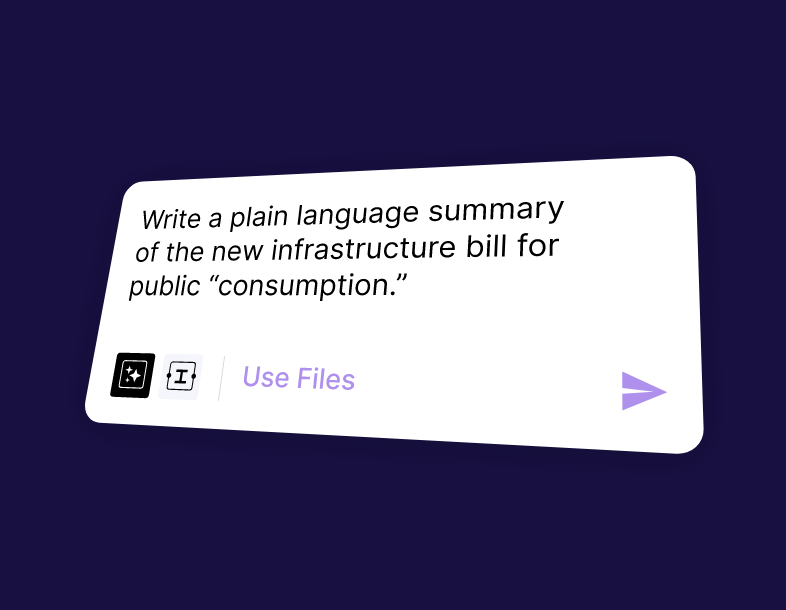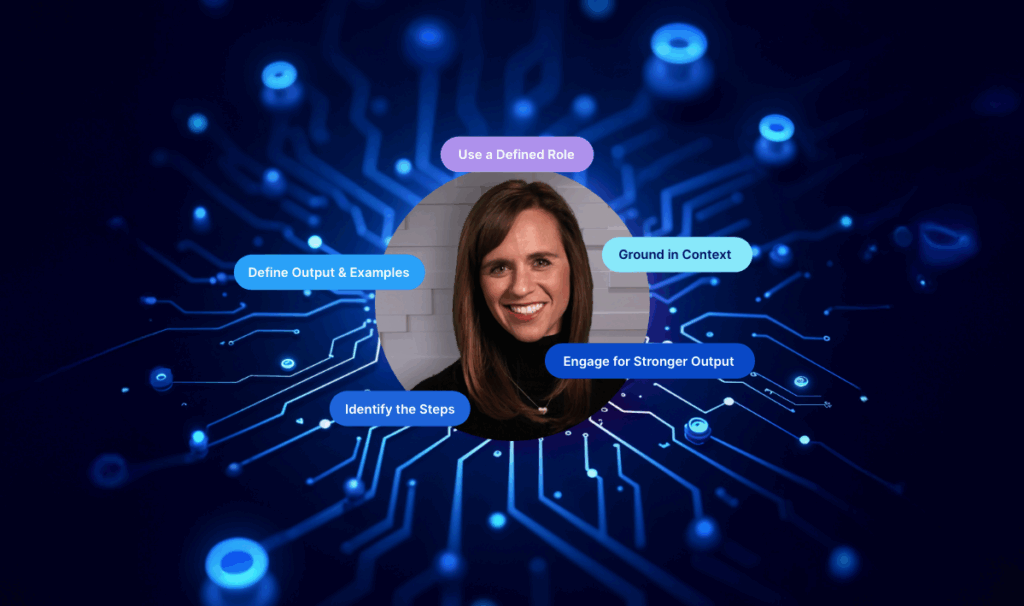This prompting cheat sheet, drawing on best practices for enterprise-level adoption, will show you how to craft prompts that consistently deliver high-quality, compliant, and on-brand results.
The Ultimate Prompt Structure: Your Enterprise AI Conversation Blueprint
Think of your prompt as a meticulously detailed instruction manual for your AI. The more precise your instructions, the more accurately your AI can meet complex enterprise requirements. Here’s a breakdown of the key elements:
Play a Role [ROLE]: Assigning a specific professional persona to your AI helps it adopt the appropriate tone, vocabulary, and perspective for internal or external enterprise communications.
Examples:
“Act as a compliance officer for a global financial services firm, reviewing a new marketing campaign for regulatory adherence.”
“Assume the role of a senior technical writer for a software development company, drafting API documentation for external developers.”
“Adopt the persona of a corporate communications specialist, preparing an internal memo for executive leadership.”
Define the Task [TASK]: Clearly state the specific enterprise-level content creation, analysis, or review task you need your AI to perform. Clarity here is crucial for avoiding irrelevant outputs and saving review time.
Examples:
“Summarize key policy changes and their implications from the latest regulatory update for an internal briefing document.”
“Draft responses to common customer support inquiries regarding complex enterprise software features, ensuring clarity and brand consistency.”
“Generate a comprehensive list of potential cybersecurity risks associated with integrating a new third-party vendor’s API.”
Add Details [DETAILS]: Provide all necessary context, internal guidelines, existing documentation, or data points crucial for the AI to produce accurate and enterprise-specific content.
Examples:
“Focus on sections pertaining to data handling, international transfer agreements, and privacy impact assessments within the provided M&A due diligence reports.”
“Include specific troubleshooting steps for network configuration issues, data synchronization errors, and user permission conflicts for our SaaS product’s latest version.”
“Consider implications for compliance with ISO 27001 standards, GDPR, and our internal corporate security policies when evaluating vendor risks.”
Set Restrictions [RESTRICTIONS]: Specify what your AI should avoid or adhere to, especially regarding legal caveats, brand voice, confidentiality, and target audience sophistication. This is vital for maintaining enterprise standards.
Examples:
“Do not provide legal advice; only summarize factual information, highlight relevant clauses, and flag areas for attorney review.”
“Avoid using technical jargon understandable only to advanced technical users; keep responses suitable for a non-technical, business-level customer audience.”
“Do not speculate on future market trends or unannounced product features; only report on currently established company positions and publicly available information.
Leveraging solutions like VT Writer that allow the AI to pull information exclusively from selected, trusted internal files guarantees that the output is precisely grounded in your organization’s verified information.
Specify Output Format [FORMAT]: Tell your AI how you want the information structured, aligning with typical enterprise document types (e.g., reports, proposals, standard operating procedures, email templates).
Examples:
“Present the regulatory update summary as a table with columns for ‘Policy Area,’ ‘New/Changed Clause,’ ‘Impact on Business Unit,’ and ‘Action Required (Internal Link).'”
“Format each customer support response as a structured FAQ entry, including a ‘Question,’ ‘Concise Answer,’ and ‘Detailed Explanation with Troubleshooting Steps.'”
“Output the cybersecurity risk assessment as a Markdown document, utilizing headings for risk categories, bullet points for individual risks, and bold text for recommended mitigation strategies.”
5 Realistic Ways to Use AI Writing Effectively in the Enterprise
Based on this ultimate prompt structure, here are five practical approaches to maximize your AI interactions within an organizational context:
Play a Role: By assigning your AI roles like a “legal review assistant,” “IT policy drafter,” or “investor relations analyst,” you ensure its output is aligned with the specific departmental needs and professional standards of your enterprise.
State Your Needs: Instead of general requests, precisely articulate enterprise-specific outcomes. For example, “Generate a concise executive summary of the quarterly financial report highlighting year-over-year growth in Q3 and key investment areas for Q4,” ensures a focused, business-relevant response.
Define the Task: Clearly delineate enterprise content creation tasks, such as “Draft a draft internal communication plan for the upcoming software migration,” “Develop a compliance checklist for new data onboarding procedures,” or “Outline a technical white paper on blockchain integration for supply chain optimization.”
Add Details: Incorporate proprietary information, brand guidelines, specific data points from internal systems, or snippets from existing enterprise documents to ground the AI’s output in your company’s unique context. This ensures accuracy and relevance for internal use.
Set Restrictions: Crucial for enterprise use, define explicit limitations. This could include “Do not include any proprietary financial figures in public-facing drafts,” “Maintain a formal and professional tone consistent with our corporate style guide,” or “Ensure all claims are backed by citations to internal research documents.”
Shaping the Output: What and How for Enterprise Applications
Beyond the core prompt, consider these aspects for enterprise-grade AI output:
What Your AI Should Do:
Recommend: Propose strategic actions based on market analysis or internal data.
Summarize: Condense lengthy legal briefs, research papers, or internal reports into actionable executive summaries.
Explain: Clarify complex technical specifications, regulatory requirements, or internal processes for various internal audiences.
Analyze: Provide insights from large datasets, conduct sentiment analysis on customer feedback, or perform competitive intelligence reviews.
Brainstorm: Generate innovative solutions for operational challenges, new product features, or marketing campaign ideas.
Compare: Highlight similarities and differences between competing products, policy drafts, or project methodologies.
Critique: Offer constructive feedback on internal documents, marketing copy, or training materials against established enterprise standards.
Generate Compliance Review Checklists: Create structured lists based on regulatory documents.
Draft Standard Operating Procedures (SOPs): Produce detailed step-by-step instructions for specific processes.
Formulate Q&A Answers: Develop official responses for internal or external FAQs.
How to Showcase the Output for Enterprise Use:
Table: Ideal for structured data, comparative analysis, or policy cross-referencing.
Bullet Points / Numbered List: Excellent for action items, key takeaways from meetings, or step-by-step guides (e.g., for SOPs).
Plain Text: Simple, straightforward output for quick internal communication or initial drafts.
Markdown / HTML: For content ready to be integrated into internal knowledge bases, technical documentation platforms, or corporate websites.
JSON / XML: For programmatic integration with business intelligence tools, CRM systems, or content management systems.
Formatted Email/Memo: For ready-to-send internal communications.
Report Structure: For comprehensive analytical or informational documents.
Elevate Your Enterprise AI Writing Game
By incorporating these enterprise-focused strategies into your daily workflow, you’ll transform your AI from a simple tool into a powerful, specialized writing assistant. Experiment with roles, clearly define your organizational needs, and leverage detailed instructions and specific restrictions. The better your prompts, the more precise, compliant, and valuable your AI-generated content will be for your entire enterprise.








